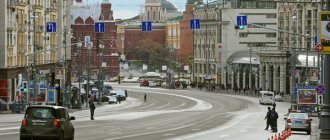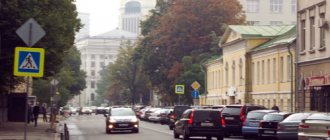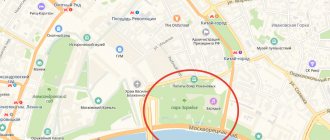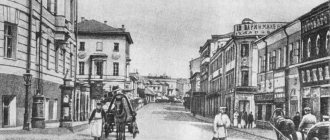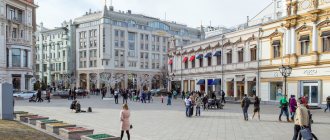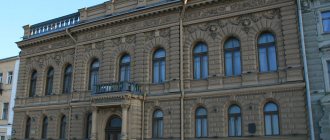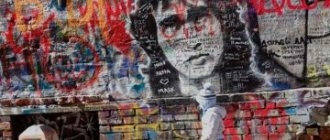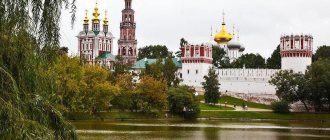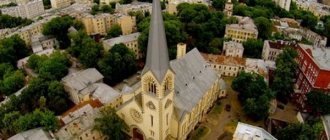Street history
Until the 19th century Maroseyka was part of one of the oldest streets in Moscow - Pokrovka. Significant territory near Pokrovka in the 15th century. was occupied by an orchard, through which the road to the village of Izmailovo ran. By the 16th century the garden fell into disrepair, and the lands located near the Kremlin began to be actively developed with residential buildings. Mostly Moscow nobility settled here - boyar families, rich nobles, favorites of the royal family.
Foreigners also really liked the place. Soon there were so many of them that representatives of the Orthodox Church complained to Tsar Mikhail Fedorovich about the sharp reduction in the Russian community on Pokrovka. The Emperor listened to the clergy and in 1643 issued a decree prohibiting the sale of land plots and houses in this part of Moscow to foreigners. In addition, several Lutheran churches were closed.
Mikhail Fedorovich's son, Alexey Mikhailovich, went even further: he forbade foreigners to settle in all areas of Moscow, except for the German Settlement, which was specially created for them. The ban was lifted only under Peter I.
Very quickly the foreigners returned to Pokrovka, however, now they were mostly not Germans, but Armenians and Little Russians. There were especially many Ukrainians who were attracted by the presence of the Little Russian Metochion on Pokrovka - a kind of transit point for residents of the Cossack region. Hetman Ivan Samoilovich built his Moscow residence not far from the courtyard.
History of Maroseyka Street
In the 15th-16th centuries, royal gardens grew in the Pokrovka area, through which the path led to the villages of Preobrazhenskoye and Izmailovo.
The close location to the Kremlin became the reason for the settlement of places along the road by the Moscow nobility. According to the 1638 census, 62 of the 83 houses located here belonged to boyar families.
Foreigners also loved these places.
Their settlement was so intense that the clergy was forced to ask for protection from Tsar Mikhail Fedorovich due to the reduction of the Orthodox community on Maroseyka. In 1643, a royal decree was issued banning the sale of houses in this area of Moscow to foreigners and closing houses of worship (ropats) belonging to the Lutheran Church.
Tsar Alexei Mikhailovich completely evicted all foreigners from Moscow to the German settlement. This happened in 1652.
Thanks to the reforms of Peter I, foreigners were again allowed to settle in Moscow. Thus, the Armenian merchants Lazarevs settled in the now existing Armenian Lane. It was they who became the founders of the Moscow community, immigrants from Armenia.
After the great fire of 1812, when the southern side of Maroseyki Street completely burned out, representatives of the merchant class settled on the street for the first time.
In addition to building new houses, merchants rebuilt the estates of the former nobility beyond recognition. For example, in the famous house of the Rumyantsevs, the new owner, merchant Kaulin, destroyed the rich interior paintings, and the merchants Grachevs generally rebuilt it into a trading courtyard. It was here that the auction office of the city of Moscow was later located. The morals of that time have a similarity with our present, isn’t it?
In the first 10 years of the twentieth century, Maroseika Street was rebuilt according to the designs of architects Lyalevich and Ivanov-Shits. True, the main buildings here remain houses from the first half of the nineteenth century.
Over the years, Ivan Mazepa, Artamon Matveev, commander Rumyantsev-Zadunaisky, Ivan Miloslavsky, and the Russian princes Saltykov and Baryatinsky lived on Maroseyka.
In Soviet times, since 1954, the street bore the name of Bohdan Khmelnytsky. Only in 1990 Maroseyka was returned to its former name.
History of the name
In the 18th century the part of Pokrovka Street, on which the Little Russian Compound was located, began to be called “Little Rossiyka”, and then simply “Maroseyka”. The toponym became so widespread among the people that the city authorities decided to formalize it. So Maroseyka Street “split off” from Pokrovka and became an independent object of urban infrastructure.
Many famous personalities lived on Maroseyka: Hetman Mazepa, Count P. Rumyantsev-Zadunaisky, one of the founders of the national theater - A. Matveev.
In 1954, in the year of celebrating the 300th anniversary of Ukraine's entry into the Russian Empire, the Soviet government decided to rename the street in honor of Bogdan Khmelnytsky. The historical name was returned to the street after the collapse of the USSR.
Origin of the street name
Many townspeople are intrigued by the unusual name of the street, which is slightly out of tune with other local streets and alleys.
Maroseyka got its name in the 17th century after the Little Russian courtyard located on it, where after the reunification of Little Russia (the historical name of a number of regions of Eastern Europe, mainly in the territory of modern Ukraine) with Russia in 1654, Little Russian merchants, diplomats, clergy and other figures who came to the city stayed . A settlement was also formed next to the courtyard, where immigrants from Little Russia settled.
The original form was “Maloroseyka”, but over time it was distorted with simplification, and the modern name was obtained.
Attractions
House of Countess V.P. Razumovskaya
The mansion in the classicist style was popularly called the “house of unlove.” This austere, beautiful building with a rounded rotunda and Doric columns was built in 1779 by Countess Varvara Razumovskaya, who had recently separated from Count Alexei Razumovsky. This marriage turned out to be extremely unsuccessful: for 10 years the couple led an unhappy life, about which all of Moscow gossiped. The Razumovskys' divorce became a high-profile social event, since in those days, divorce was extremely rare.
In the new house, the Countess lived quietly and secludedly; she completely refused to go out into society. The reclusive life of Varvara Petrovna aroused respect among Muscovites: many considered her almost a saint. These rumors became stronger after Razumovskaya’s house became one of the few buildings in Moscow that was not damaged by the fire of 1812.
In the 19th century The mansion was purchased by the wealthy noblewoman V. Popova. By order of the new owner, the famous architect V. Balashov added an outbuilding and a store to the house. Most of the premises began to be rented. At the beginning of the 20th century. the house housed a tavern and a pharmacy. The pharmacy has survived to this day: it is one of the oldest points of sale of medicines in Moscow.
Address: Moscow, st. Maroseyka, 2
St. Nicholas Church in Klenniki
A small church with a single dome and a small bell tower. Decorated in red and white tones, the building resembles a fairytale tower. The Church of St. Nicholas in Klenniki was erected in 1657 on the preserved foundation of the ancient temple of 1468.
The origin of the name is not completely clear. It is known that the temple was originally called the “Church of St. Nicholas in Blinniki” (this area was famous for its pancake shops). Gradually the word “Bliniki” changed into “Klenniki”. Nowadays, both options are considered quite acceptable.
The church on Maroseyka became especially famous at the end of the 19th – beginning of the 20th centuries. At this time, the rector of the temple was Alexy Mechev, an archpriest who became famous throughout Russia for his kindness and desire to help his neighbor. Walkers from all over the country came to talk with the shepherd.
In 1931, a warehouse was organized in the church, then the building was transferred to the district administration of the Komsomol. The interiors of the temple were destroyed, but the facades remained in good condition. In 2000, Archpriest A. Mechev and his son, priest S. Mechev, who died in the Gulag, were canonized by the Russian Orthodox Church. In memory of the ascetics, memorial altar-chapels are located on the lower floor of St. Nicholas in Klenniki.
Address: Moscow, st. Maroseyka, 5
Estate of Rumyantsev-Zadunaisky
In 1782, architects V. Bazhenov and M. Kazakov built a beautiful estate on Maroseyka for the distinguished Count P. Rumyantsev-Zadunaisky. Soon the count died, and until 1826 the complex of buildings was owned by his son, N.P. Rumyantsev-Zadunaisky is a lover of fine arts, the founder of the Rumyantsev Museum. Nikolai Petrovich was visited by outstanding personalities of that time - historian N. Karamzin, poets P. Vyazemsky, V. Zhukovsky, I. Dmitriev.
In 1880, the architect G. Kaiser slightly changed the appearance of the building by order of the entrepreneur M. Grachev. Additional decorations were applied to the facade - statues of women, stucco moldings, coats of arms. The ground floor of the mansion housed shops and warehouses, and the second floor housed residential premises.
In 1912, the second floor was occupied by the Russian branch of the German corporation Siemens. The representative office was headed by L. Krasin, who later became an ardent revolutionary and a key ally of V. Lenin.
Currently, the Belarusian embassy is located in the Rumyantsev-Zadunaisky estate.
Address: Moscow, st. Maroseyka, 17
House "Triangle"
This four-story building in the classical Art Nouveau style was erected at the beginning of the 20th century. commissioned by the Berg brothers, owners of the largest rubber factory in Russia, Triangle. The mansion housed the headquarters of the Berg business empire.
The author of the project was the famous architect M. Lyalevich, who built many buildings in St. Petersburg. “Triangle” can well be called a piece of the Northern capital in Moscow. The building with a courtyard-well and a strict portico with eight Doric columns gives quite a “St. Petersburg” impression.
After the revolution, the Triangle manufactory was renamed Rezinotrest, which inherited all the company’s property. Subsequently, the building was occupied by Soviet ministries.
Currently, the Triangle house houses the Russian Federal Drug Control Service.
Address: Moscow, st. Maroseyka, 12
Sytin's House
By the standards of the beginning of the 20th century. the huge six-story Sytin House looked like a real skyscraper. This amazing building in the Art Nouveau style was erected by the architect A. Erichson by order of the publishing partnership of Ivan Dmitrievich Sytin, the largest publisher of fiction, textbooks, newspapers and magazines in the Russian Empire.
Sytin was the author of many publishing projects that were extremely popular in the late 19th and early 20th centuries. The newspaper “Russkoe Slovo” was booming throughout the country, children were reading the magazine “Pchelka”, and adults were reading “Around the World”. In addition, Sytin did a lot of charity work.
The Sytin House housed the main office of the publishing house, the editorial offices of newspapers and magazines, warehouses, as well as a bookstore famous throughout Moscow. There were apartments on the upper floors.
For the sake of building the Sytin House, the palace of the Shakhovsky princes, an architectural masterpiece of the 18th century, was demolished. in the Baroque style: historians are still arguing about the appropriateness of this “replacement”.
Address: Moscow, st. Maroseyka, 7
Church of Kuzma and Demyan
A neat church with two large squat domes was built in 1793 by the architect M. Kazakov. Colonel M. Khlebnikov allocated money for the construction of the building.
The Church of Kuzma and Demyan is known for its famous parishioners. For example, F. Tyutchev and F. Dostoevsky prayed here.
Under Soviet rule, the church was closed, but they did not demolish it. On the contrary, in 1958 the Moscow authorities allocated funds for the complete restoration of the temple.
Address: Moscow, st. Maroseyka, 14
A short video with the sights of Maroseyki Street:
Maroseyka is... What is Maroseyka?
Maroseyka Street
(1954-1990 -
Bogdan Khmelnitsky Street
) - a street in the Central Administrative District of Moscow (Basmanny Municipal District). It runs from Ilyinskie Vorota Square to Pokrovka Street (intersection with Armenian and Starosadsky lanes). The numbering of houses starts from Ilyinskie Vorota Square. In addition to those mentioned, the street faces the following lanes: from the odd, northern side, B. Zlatoustinsky, from the even side, B. Spasoglinishevsky and Petroverigsky.
origin of name
Maroseyka is part of the ancient Pokrovskaya Street and received its name in the 17th century from the Little Russian courtyard, which was located on the corner of Maroseyka and Bolshoy Zlatoustinsky lanes, on the site of the current houses No. 9 and 11. Representatives of the Little Russian hetmans who came from Little Russia stayed in the courtyard.
In the 17th century, Maroseyka extended to the Pokrovsky Gate. The division of old Pokrovka into Pokrovka and Maroseyka was established in the first half of the 19th century (the 1853 atlas shows the streets within their current boundaries).
On January 6, 1954, by a resolution of the Moscow City Council, in commemoration of the 300th anniversary of the reunification of Ukraine with Russia, Maroseyka was renamed Bogdan Khmelnitsky Street. In 1990, the street's historical name was returned.
Story
In the 15th-16th centuries, the royal gardens were located on Pokrovka; The “royal road” along Maroseyka to Preobrazhenskoye and Izmailovo attracted nobility. In 1638, out of 83 houses on Maroseyka, 62 were occupied by representatives of boyar families. At the same time, foreigners settled on the street. The reduction of the Orthodox flock prompted the clergy to seek protection from Mikhail Fedorovich, and in 1643 a decree was issued prohibiting the purchase of households by foreigners and closing the so-called. ropata
- Lutheran houses of worship. Alexey Mikhailovich in 1652 completely evicted all Europeans from the city - to the German Settlement. At the end of the 17th - beginning of the 18th century, Artamon Matveev, Ivan Miloslavsky, and Ivan Mazepa lived on Maroseyka.
After Peter's reforms, foreigners returned to Maroseyka again. The Lazarev Armenian merchant dynasty settled in what is now Armenian Lane, becoming the core of the Moscow Armenian community. On Maroseyka lived the commander P. A. Rumyantsev-Zadunaisky, the Baryatinsky and Saltykov princes. However, after the fire of 1812, which destroyed the southern side of the street, all the houses passed into the hands of the merchants. In the 1840s. the new owner of the Rumyantsev house, merchant Kaulin, destroyed the interior paintings, and in the 1880s. the house was completely rebuilt by the Grachev merchants into a trading compound; The City Auction Office was based here.
In the 1900s-1910s, Maroseyka was rebuilt by architects I. A. Ivanov-Shits and M. S. Lyalevich, but most of the street to this day retains the buildings of the first half of the 19th century.
Notable buildings
On the odd side:
On the even side:
Street in fiction and art
“Rus' is in a kitschka, in a red jacket, She seems to be a hundred years old, She lives on Maroseyka, But she doesn’t care about Europe.”
Notes
Literature
- Sytin P.V. From the history of Moscow streets. - M., 1948.
- Muravyov V.B. Moscow streets. Secrets of renaming. - M.: Algorithm, Eksmo, 2006. ISBN 5-699-17008-1
Links
Wikimedia Foundation. 2010.
dic.academic.ru
Maroseyka Street
In the 16th-17th centuries, Maroseyka, together with modern Pokrovka Street, bore the common name Pokrovskaya, or Pokrovka, after the Intercession Church of the Dormition of the Mother of God that stood on it. The church was first mentioned in chronicles in 1488 as “Pokrova v Sadekh” (demolished in 1777). “In Sadekh”, because here was the country court of Ivan III with luxurious orchards, where he moved from the Kremlin after the terrible fire of 1491. Then a street arose that stretched along the road from the Kremlin to the grand ducal gardens. The kings and their inner circle often traveled along it. In the 16th century, a new Sovereign Garden was laid out in Zamoskvorechye, and the local gardens began to be called Old, as modern Starosadsky Lane recalls. In the 18th century, Maroseyka stretched to the Pokrovsky Gate and only in the 19th century began to reach Armenian Lane.
In 1657, the Church of St. Nicholas the Wonderworker was built here, in Blinniki, or also known by the second definition, in Klenniki. The church has survived to this day (Maroseyka, 5). Its first definition indicates that masters who made pancakes lived here at that time, and the second is known for the maple grove that was in this place in the old days. The main altar was consecrated in the name of the Kazan Mother of God, and St. Nicholas the Wonderworker's chapel.
In the 17th century, foreigners settled on the street and built “ropats”—Lutheran prayer houses—in their courtyards. Naturally, the local clergy did not like the reduction of Orthodox households in the parishes, and at his request, Tsar Mikhail Fedorovich closed the “Ropati” in 1643 and prohibited the future purchase of households here by foreigners. This, perhaps, was the first step towards the complete eviction of foreigners in 1652 to the banks of the Yauza in the “German Settlement” built there. In 1670, the street began behind the bridge over the moat at the Ilyinsky Gate of Kitay-Gorod. Between modern Armenian and Starosadsky lanes there was a “grid”, at which local people were on duty at night. In the old days, “lattices” were the name given to wooden outposts at the end of streets that were locked at night.
At the end of the 17th century, on Maroseyka and in its alleys there were courtyards of a relative of Tsar Alexei Mikhailovich by his first wife, boyar I.M. Miloslavsky and the famous boyar A.S. Matveev, where the widower tsar saw his pupil Natalya Naryshkina, who soon became his second wife and mother of Peter I. In the current Starosadsky Lane there was the courtyard of Hetman Ivan Mazepa. At the end of the 17th - beginning of the 18th century, Maroseyka had a width of 4.5 to 6 fathoms, sometimes expanding and sometimes narrowing. There were many churches and noble courtyards on the street. This was the road of the kings who drove along Maroseyka to the banks of the Yauza River and Pokrovskoye (Rubtsovo), Izmailovo and the Preobrazhensky Palace and stopped on the way to visit the boyars' houses. Only Peter I, from the end of the 17th century, began to travel to the Kremlin not along this street, but along Myasnitskaya. And most likely with his permission, in the 18th century foreigners, mostly Armenians, again began to buy houses here. At the corner of Armenian Lane and Maroseyka, a house (No. 17) that belonged to Field Marshal Count P.A. in the 1790s has survived to this day. Rumyantsev-Zadunaisky. Here, in many rooms of the palace, there were paintings and bas-relief images of battles in which Zadunaisky took part. Nowadays, the ancient palace houses the Embassy of the Republic of Belarus.
In 1791-1793, the architect Matvey Kazakov built the Church of Cosmas and Damian, which has also survived to this day (Maroseyka, 14/2). Previously, there was a brick temple on this site, known since 1639, and before it there was a wooden church, which is mentioned in connection with the fire of 1547. In modern Moscow, a multi-storey administrative building was built behind the church building in 1972, which, according to lovers of Moscow antiquity, hopelessly spoiled the appearance of the church. After the fire of 1812 and the demolition of the earthworks of Peter I in front of the Ilyinsky Gate, a square was formed in their place, where Apple Rows stood until the 1880s. The fire of 1812 destroyed the right side of Maroseyka, but barely touched the left. After the fire, the street was expanded, most of the houses passed into the hands of merchants. The fate of ancient houses in the hands of ordinary merchants is well illustrated by the house of Rumyantsev-Zadunaisky. In 1840, the merchant Shcheglov, having bought this house, scraped and cleaned all its decorations from the ceilings and walls, and the new owner, merchant Kaulin, destroyed the large beautiful garden. After Kaulin, the Grachev merchants converted the entire house into apartments and retail space. In 1888, in one of the halves of the mezzanine of this house, the City Auction Office was located, where the houses and estates of bankrupt nobles and merchants were sold daily under the hammer.
At the beginning of the street in the 1890s, the building of the Polytechnic Institute overlooking it was built, and on the contrary, on the site of Apple Rows, back in the 1880s, a square was laid out and a monument to those who fell in 1878 during the capture of the Turkish fortress of Plevna was erected (architect V .O.Sherwood). Under Soviet rule, the street was renamed and from 1954 to 1990 it was called Bohdan Khmelnytsky Street. District: Central, Basmanny. Nearby metro: Kitai-Gorod. Former street names: Pokrovka, Bohdan Khmelnitsky Street.
